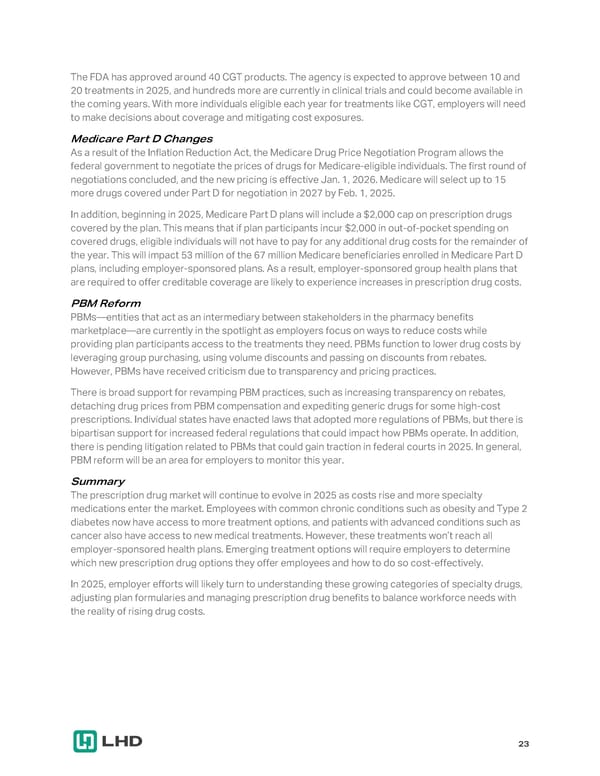The FDA has approved around 40 CGT products. The agency is expected to approve between 10 and 20 treatments in 2025, and hundreds more are currently in clinical trials and could become available in the coming years. With more individuals eligible each year for treatments like CGT, employers will need to make decisions about coverage and mitigating cost exposures. Medicare Part D Changes As a result of the Inflation Reduction Act, the Medicare Drug Price Negotiation Program allows the federal government to negotiate the prices of drugs for Medicare-eligible individuals. The first round of negotiations concluded, and the new pricing is effective Jan. 1, 2026. Medicare will select up to 15 more drugs covered under Part D for negotiation in 2027 by Feb. 1, 2025. In addition, beginning in 2025, Medicare Part D plans will include a $2,000 cap on prescription drugs covered by the plan. This means that if plan participants incur $2,000 in out-of-pocket spending on covered drugs, eligible individuals will not have to pay for any additional drug costs for the remainder of the year. This will impact 53 million of the 67 million Medicare beneficiaries enrolled in Medicare Part D plans, including employer-sponsored plans. As a result, employer-sponsored group health plans that are required to offer creditable coverage are likely to experience increases in prescription drug costs. PBM Reform PBMs—entities that act as an intermediary between stakeholders in the pharmacy benefits marketplace—are currently in the spotlight as employers focus on ways to reduce costs while providing plan participants access to the treatments they need. PBMs function to lower drug costs by leveraging group purchasing, using volume discounts and passing on discounts from rebates. However, PBMs have received criticism due to transparency and pricing practices. There is broad support for revamping PBM practices, such as increasing transparency on rebates, detaching drug prices from PBM compensation and expediting generic drugs for some high-cost prescriptions. Individual states have enacted laws that adopted more regulations of PBMs, but there is bipartisan support for increased federal regulations that could impact how PBMs operate. In addition, there is pending litigation related to PBMs that could gain traction in federal courts in 2025. In general, PBM reform will be an area for employers to monitor this year. Summary The prescription drug market will continue to evolve in 2025 as costs rise and more specialty medications enter the market. Employees with common chronic conditions such as obesity and Type 2 diabetes now have access to more treatment options, and patients with advanced conditions such as cancer also have access to new medical treatments. However, these treatments won’t reach all employer-sponsored health plans. Emerging treatment options will require employers to determine which new prescription drug options they offer employees and how to do so cost-effectively. In 2025, employer efforts will likely turn to understanding these growing categories of specialty drugs, adjusting plan formularies and managing prescription drug benefits to balance workforce needs with the reality of rising drug costs. 23
 2025 Employee Benefits Market Outlook Page 22 Page 24
2025 Employee Benefits Market Outlook Page 22 Page 24